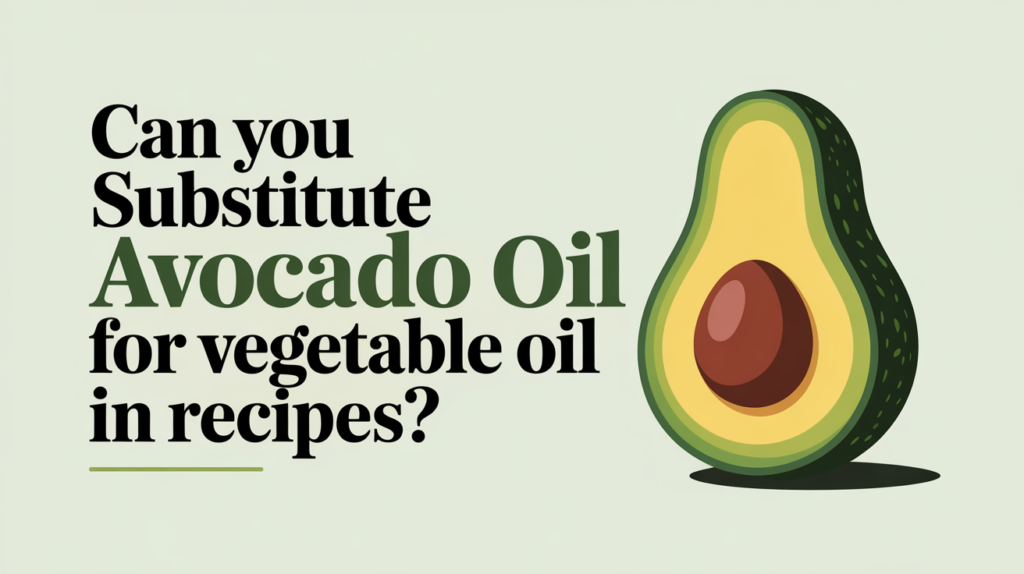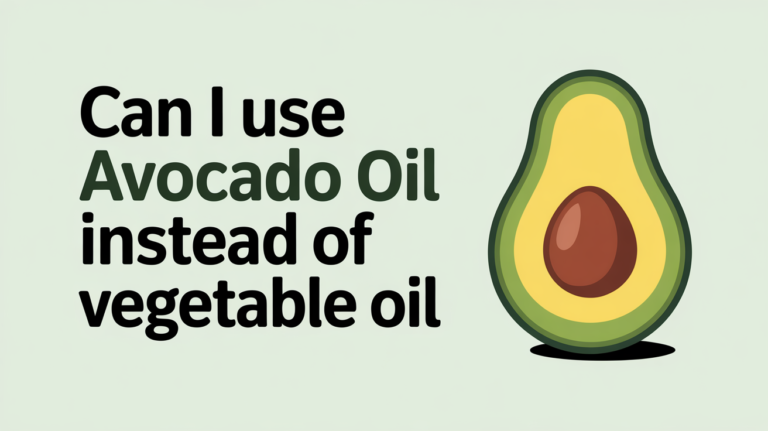Yes, you can use avocado oil instead of vegetable oil in most recipes.
It’s a healthy, versatile alternative that works well for baking, frying, and sautéing—thanks to its neutral taste and high smoke point.
Avocado oil has become a popular pantry staple, but many home cooks still wonder if it can truly replace vegetable oil in everyday meals. Maybe you’re in the middle of a recipe and just realized you’re out of vegetable oil—or you’re looking for a healthier swap. Either way, you’re not alone.
The good news? This article makes it easy to understand when and how to make the switch. Let’s walk through each cooking method, nutrition tip, and real-world example to help you cook with confidence.
Contents
Avocado Oil vs. Vegetable Oil: What’s the Difference?
Avocado oil and vegetable oil may look alike in the bottle, but they’re very different in how they’re made, used, and how they affect your health. Knowing these key differences can help you make smarter choices in the kitchen.
Avocado oil is made by pressing the pulp of ripe avocados. It’s a natural oil that’s rich in healthy fats, especially monounsaturated fats, which are good for your heart. It has a clean, mild flavor and works well in both cooking and baking.
Vegetable oil, on the other hand, is usually made from a blend of plant oils like soybean, corn, sunflower, or canola. It often goes through heavy processing, which may strip away some nutrients. It has a neutral taste and is often used in baking or frying because it’s affordable and easy to find.
Here’s a quick look at how they compare:
| Feature | Avocado Oil | Vegetable Oil |
|---|---|---|
| Source | Pressed from avocado pulp | Blend of oils (soybean, corn, canola, etc.) |
| Smoke Point | ~520°F (refined) source | ~400°F (varies by blend) |
| Taste | Mild, slightly nutty | Neutral |
| Fat Type | Mostly monounsaturated | Varies, often high in omega-6 fats |
| Processing Level | Minimally processed (cold-pressed/refined) | Often refined, processed with chemicals |
| Nutrition Profile | High in Vitamin E and antioxidants | Less nutrient-dense |
| Common Uses | Sautéing, roasting, baking, salad dressing | Frying, baking, sautéing |
Both oils have their place, but avocado oil is often the healthier choice, especially for high-heat cooking and heart-friendly recipes. If you’re curious about oil types, check this Harvard guide on cooking oils for deeper insights.
Can You Substitute Avocado Oil for Vegetable Oil in Recipes?

Yes, in most recipes, you can safely substitute avocado oil for vegetable oil. Both have similar cooking properties, so the swap won’t mess up your results. It works for frying, roasting, and baking.
Here’s what to keep in mind:
In Baking: Avocado oil can replace vegetable oil at a 1:1 ratio. Its mild flavor won’t overpower sweet treats like brownies, cakes, or muffins. It may even make them a bit more moist due to its rich fat content.
In Frying: Avocado oil has a much higher smoke point than vegetable oil. That means it can handle high heat without burning or breaking down. It’s perfect for deep frying, pan-frying, or stir-frying. Learn more about cooking with high smoke point oils.
In Sautéing or Roasting: You’ll notice no real difference in texture or performance. Just pour and use as you normally would.
Flavor Impact: Avocado oil has a slight buttery, nutty taste, but it’s very light. Most people don’t even notice the change when using it in dishes that originally call for vegetable oil.
Cost: Yes, avocado oil tends to be more expensive. But it’s also more stable, lasts longer, and delivers added health benefits.
Pro Tip: If you’re unsure about flavor, try it first in a neutral recipe like roasted veggies or scrambled eggs.
Using Avocado Oil in Specific Cooking Methods
Baking
Avocado oil works great in baked goods. Whether it’s cakes, muffins, or quick breads, you can swap it in without adjusting the amount. Its healthy fats help keep your desserts moist and tender. Since it doesn’t add a strong taste, it won’t affect the flavor of cookies or brownies. You can use it in recipes like this banana bread with avocado oil and get great results.
Frying
Thanks to its high smoke point (about 520°F), avocado oil is perfect for frying. It doesn’t break down or smoke easily, making it safer and cleaner to cook with. It’s a better option than many vegetable oil blends, which may smoke or turn bitter at high temperatures. You can use it to fry chicken, tofu, or vegetables.
Sautéing & Roasting
Avocado oil’s mild taste and high heat resistance make it ideal for sautéing meats and vegetables. It also works well for roasting in the oven. Drizzle it over potatoes or carrots before baking, and you’ll get a nice golden finish without any weird aftertaste.
When you cook often, using a stable oil like avocado oil can help reduce harmful oxidation. That’s why it’s becoming a favorite in health-focused kitchens across the U.S.
Great! Here’s the next section based on your outline, keeping the readability high and following your detailed instructions:
Taste and Texture Differences
When you swap vegetable oil with avocado oil, the change in taste and texture is usually small—but worth knowing about, especially if you’re baking.
Taste
Avocado oil has a mild, buttery, slightly nutty flavor. It’s not as flavorless as vegetable oil, but it’s subtle enough that most people won’t notice it. In savory dishes like roasted vegetables or grilled chicken, this added depth can actually enhance the flavor.
In sweet dishes, the flavor blends in nicely. You might detect a hint of richness in items like muffins or pancakes, but it won’t overpower the recipe. That’s why many bakers now prefer avocado oil in place of heavily refined oils. If you’re unsure, try a small batch first to see how it tastes in your recipe.
Texture
When it comes to texture, avocado oil performs just like vegetable oil. It coats ingredients evenly, locks in moisture, and helps with browning. In baked goods, it can even improve the softness of cakes and quick breads.
Because avocado oil is rich in monounsaturated fats, it may make your final dish feel smoother and less greasy compared to traditional vegetable oil, which often contains more polyunsaturated fats or processed blends.
In Summary:
- Savory dishes: Flavor is enhanced with a mild buttery taste
- Baked goods: Slight richness added, but still neutral enough
- Texture: Moist and smooth, no greasy finish
- No need to adjust measurements—just replace 1:1
For more on how oils affect baking texture and flavor, the Kitchn guide on cooking oils offers helpful insights.
Absolutely! Here’s the continuation of your article, covering the Health Benefits, Cost and Availability Comparison, FAQs, and Conclusion, all optimized for readability, clarity, and SEO as per your instructions.
Health Benefits of Avocado Oil
Avocado oil isn’t just a cooking substitute—it’s a nutritional upgrade. It’s packed with healthy fats, vitamins, and antioxidants that make it one of the best oils for your kitchen.
Heart Health
Avocado oil is rich in monounsaturated fats, which are known to support heart health. These fats help lower bad cholesterol (LDL) and raise good cholesterol (HDL). According to the American Heart Association, oils high in monounsaturated fat can reduce the risk of heart disease when used instead of saturated or trans fats.
Rich in Antioxidants
Avocado oil contains vitamin E, a powerful antioxidant that supports immune health and protects your body from oxidative stress. It also has lutein, which supports eye health and may reduce the risk of age-related eye issues.
Anti-Inflammatory Properties
Avocado oil has been linked to reduced inflammation, especially in the joints. Some studies even suggest it may help with symptoms of arthritis. Its natural anti-inflammatory compounds, like phytosterols and oleic acid, make it a great option for people looking to support joint health through diet.
Supports Nutrient Absorption
Because it’s a fat-soluble oil, avocado oil helps your body absorb fat-soluble vitamins like A, D, E, and K. Drizzling it over vegetables can help your body get more nutrients from your meal.
Key Takeaway: If you’re trying to eat clean or reduce processed ingredients, avocado oil is a smart, natural swap with real health benefits.
Cost and Availability Comparison
Avocado oil is more expensive than vegetable oil—but let’s break down why, and whether it’s worth it.
| Feature | Avocado Oil | Vegetable Oil |
|---|---|---|
| Average Price (USA) | $7–$15 per liter | $2–$4 per liter |
| Shelf Life | Up to 12 months (cool, dark storage) | 6–12 months |
| Availability | Found at Walmart, Whole Foods, Amazon | Found in all grocery stores |
| Organic Options | Widely available | Less common |
While avocado oil costs more upfront, you use it in the same amounts and benefit from its longer shelf life and better nutrition. For many home cooks, that makes the switch worth it.
Look for refined avocado oil for high-heat cooking and cold-pressed or unrefined oil for dressings and low-heat uses. Reputable brands like Chosen Foods and Primal Kitchen are available on Amazon and at most health stores.
FAQs
Can I use avocado oil for frying chicken or fish?
Yes! Avocado oil is great for frying due to its high smoke point. It helps food cook evenly without burning and gives a crispy texture.
Will avocado oil change the taste of my food?
Not much. It has a mild flavor that blends well with both savory and sweet dishes. In most cases, you won’t even notice a difference.
Is avocado oil healthier than vegetable oil?
Yes. It’s less processed and higher in heart-healthy fats and antioxidants. Vegetable oil blends can include processed seed oils that may be higher in omega-6 fats, which some health experts recommend limiting.
Can I use avocado oil for baking cakes or brownies?
Absolutely. You can use it at a 1:1 ratio, and it will keep your baked goods moist without changing the flavor.
Does avocado oil go bad?
Like all oils, it can go rancid. Store it in a cool, dark place and use it within 6 to 12 months. It should smell clean and neutral—if it smells sour, it’s time to toss it.
Conclusion
Yes, you can use avocado oil instead of vegetable oil—and often get better results.
It’s a healthier, heat-stable, and flexible option that works in just about any recipe—from frying and roasting to baking and sautéing.
While the price is higher, the health benefits and cooking performance make it a smart upgrade for everyday meals. Now that you know when and how to use it, try swapping it in your next dish and taste the difference for yourself.

